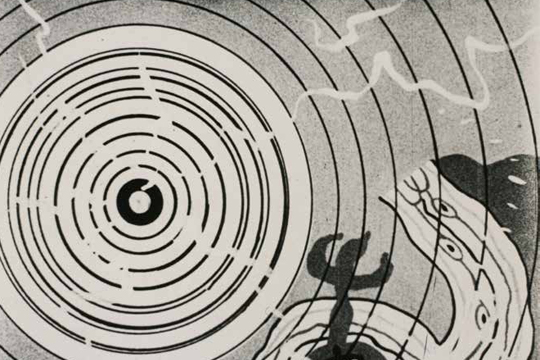ANIMISM
| February 12, 2014 | Post In LEAP 23

At its core, the exhibition “Animism” is a European export. Now, produced under circumstances of limited financial resources, it has been introduced into China and Asia for the first time. On the surface, German curator Anselm Franke works from aesthetic and anthropological perspectives to raise an anti-modernist proposal for the order of knowledge. From participating in “Magiciens de la Terre” in 1989 until today, China’s art practitioners have been disposed to leverage the identity politics of difference in order to establish their position within the globalized art system. Due to recent calls by European scholars to transcend difference and find commonality, this exhibition and the thought system it beholds merit our closer attention.
In “Animism,” the discussion of subject, object, and equality is broadened from traditional humanism and into the realms of psychism, life, inorganic matter, and man-made objects. Evident throughout the exhibition is a basically universalist value system. Examples include the study of minority ethnicities and aboriginal works, such as the film Tusalava (1929) by pioneering avant-garde artist Len Lye, who researched the native tribes of Australia, New Zealand, and Samoa. There are León Ferrari’s collages L’Osservatore Romano (2001-2007); works that use natural objects as medium for mystical experiences, such as Adam Avikainen’s Shenzhen residency project Man go, jack fruit (2013); and works touching upon the relationship between artificially synthesized materials, new technologies, and psychism, such Daria Martin’s film Soft Material (2004), which explores the interaction between a group of robots and two dancers.
Universalism emphasizes transcending national, religious, and individual boundaries to arrive at a universal reality and understanding. In an interview with e-flux journal, Franke cited Stewart Brand’s The Whole Earth Catalog from the 1960s as an example for discussing the close relationship between universalism and artistic practice. Today, Brand is known as an environmentalist who is concerned with ecological degradation and the global problem of urbanization. But back in the 1960s he launched a movement to compel the publication of NASA satellite photographs of the earth, distributing buttons with the slogan, “Why haven’t we seen a photograph of the whole Earth yet?” This slogan and the subsequently released photograph of the earth, known as the “Blue Marble,” were then appropriated as political propaganda. In the image, parts of the globe could not be seen, clearly in reference to the Soviet Union and other Communist countries. In 1947, during the Turkey and Greece crisis, the United States began openly expressing universalism as policy under the guise of the Truman Doctrine, where the goal was to help any country whose freedom was threatened by Russia. This theory became the dominant ideology during the Cold War, replacing the Monroe Doctrine that took geographical boundaries as its organizing principle. The blue earth concept as advocated by Brand, along with the increasingly popular California lifestyle, were used by the American government as anti-Soviet propaganda tools.
After the Cold War, as globalization began to spread in earnest, universalism continued to expand and develop. The return of animism is its latest development: It brings the concept of human equality to include nature, religion, and even inanimate matter, thereby entering a new period. Yet, these strains of universalism and equality are not limited to cultural and ethical demands.
For example, in 2008, Ecuador put into effect a new constitution that incorporated natural resources into the existing legal structure, declaring that rivers, mountains, rocks, and the oceans enjoy the same legal rights as humans. This event became the inspiration for Brazilian architect Paulo Tavares’s film installation, which is also shown during the exhibition. Ecuador’s new constitution is a representative example of an animistic conception of the world. It sounds like something from a happy fairy tale. But, the real world is not a fairy tale. After the constitution went into effect, the Ecuadorean government increased its control of natural resources through large state-owned enterprises, reduced foreign capital, and expanded its control of oil and coal stocks. In terms of economics and politics, Ecuador’s new constitution has strong overtones of nationalism and anti-neoliberal economics. Yet fortunately, in the last five years, Ecuador’s new constitution has had the effect of accelerated economic growth. But for developing countries whose industrial infrastructure is more complete and have yet to find their positions in the globalized economy, such as China, Brazil, and India, this type of rights scheme based on absolute equality can only bring more problems.
More and more people are beginning to recognize that transcending modernity has become an internal drive for Europe. This goal catalyzed the exhibition’s proposals, and determined its pluralist and decentralizing pursuit of broad global connections. Equality is a lubricant and a talisman, at least from a moral perspective. Economically, the supporters of neoliberalism prefer the suggestion and establishment of a homogenous, flattened international market. But the issue remains that equality has not eliminated the hierarchical order of production; politically, the differences created by identity politics will not disappear in any short amount of time. As a result, talk about equality outside of the context of society and economics lacks practicability. The reality is that today’s capitalist economy remains one of oppression.
We can say that as a suggestion for crisis ethics, the significance of “Animism” lies in providing those of us who work within a different system a position of reference. Culturally, we are always wavering between extremes of pride and inferiority, unable to find a balance; we excel at showing off, but lack the volition for reflection. At the same time, the various European responses to crisis do not signal that they face imminent collapse; this is just a part of their tradition. Since the early days of modernism, Europe has continuously faced all manner of crisis. This sense of imminent crisis and ensuing anxiety benefitted from modernist thinking, that generative mechanism of resistance and reflection. Viewed from this perspective, “Animism” is a quintessential product of this system.

